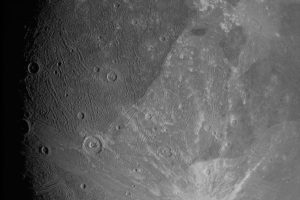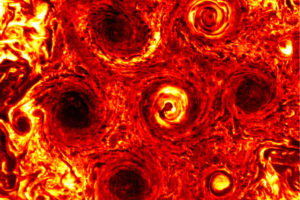画像の説明
Mystery In this animated GIF, the clouds on the periphery of some of Jupiter’s polar cyclones rotate counterclockwise, while the core of the cyclones rotate clockwise. The JunoCam images used for this animation were taken from altitudes of about 18,000 miles (28,567 kilometers) above Jupiter’s cloud tops. Citizen scientist Gerald Eichstädt processed the images to enhance the color and contrast.
Credits: Image data: NASA/JPL-Caltech/SwRI/MSSS. Image processing: Gerald Eichstädt © CC BY
この不思議なアニメーションGIFは、木星の極にあるサイクロン周辺の雲が反時計回りに回転し、サイクロンのコアが時計回りに回転している様を表わしています。このアニメーションに使用されたジュノーカムの画像は、木星の大気上空約18,000マイル(28,567キロメートル)の高度から撮影されたものです。民間科学者のGeraldEichstädtが画像処理し、色とコントラストを強調したものです。
NASAの新しい公開記事です。
NASA’s Juno Spacecraft Updates Quarter-Century Jupiter Mystery
Jupiter
2020年12月11日付のこの記事の概要は以下となります。
木星大気に渦巻く気象現象には大赤斑を始めとして不思議なものが多いのですが、木星の極に存在する五角形の配置をした奇妙な渦もその中の一つです。
NASAによる本記事によると、その渦は周辺が反時計回り、しかし中心部は時計回りをしているというのです。
この記事では、2020年12月11日から開催されているアメリカ地球物理学連合でのレポート記事(木星大気のホットスポットに関する科学的考察)を動画を交えて掲載しています。
ただしここでは、謎を解き明かすカギになりそうな新しい知見は提示されていません。
記事原文と和訳は以下となります。
NASA’s Juno Spacecraft Updates Quarter-Century Jupiter Mystery
Jupiter
The spacecraft has been collecting data on the gas giant’s interior since July 2016. Some of its latest findings touch on “hot spots” in the planet’s atmosphere.
NASAの木星探査機ジュノーは、2016年7月から巨大ガス惑星である木星内部に関するデータを収集しています。その最新調査結果のいくつかは、木星大気中の「ホットスポット」についてのものです。
Twenty-five years ago, NASA sent history’s first probe into the atmosphere of the solar system’s largest planet. But the information returned by the Galileo probe during its descent into Jupiter caused head-scratching: The atmosphere it was plunging into was much denser and hotter than scientists expected. New data from NASA’s Juno spacecraft suggests that these “hot spots” are much wider and deeper than anticipated. The findings on Jupiter’s hot spots, along with an update on Jupiter’s polar cyclones, were revealed on Dec. 11, during a virtual media briefing at the American Geophysical Union’s fall conference.
25年前、NASAは太陽系最大の惑星である木星の大気を調べるために、歴史上最初の探査機を送りました。しかし、木星大気中を降下したガリレオプローブによってもたらされた情報で、科学者たちが頭をかきむしることになりました。ガリレオプローブが突入した大気は、科学者が予想したよりもはるかに高密度かつ高熱であったのです。 NASAのジュノー探査機からの新しいデータは、これらの「ホットスポット」が予想よりもはるかに広く深いものであることを示唆しています。木星のホットスポットに関する調査結果は、木星の極に存在しているサイクロンに関する最新情報とともに、12月11日、アメリカ地球物理学連合の秋の会議でネット配信で行われた記者会見の場で明らかにされました。
“Giant planets have deep atmospheres without a solid or liquid base like Earth,” said Scott Bolton, principal investigator of Juno at the Southwest Research Institute in San Antonio. “To better understand what is happening deep into one of these worlds, you need to look below the cloud layer. Juno, which recently completed its 29th close-up science pass of Jupiter, does just that. The spacecraft’s observations are shedding light on old mysteries and posing new questions – not only about Jupiter, but about all gas giant worlds.”
サンアントニオのサウスウエスト研究所のジュノの主任研究員であるスコット・ボルトンは、「巨大惑星は、地球のような固体または液体の基盤を持たない深い大気を持っています」と述べています。 「そうした深い大気の内部では何が起こっているのかをよりよく理解するには、大気上層部の雲の下を見る必要があります。直近である29回目の木星への最接近を終えたジュノーにより、まさにその科学的な分析を行っています。探査機による観測は古い謎に光を当てるものですが木星に限らずすべての巨大ガス惑星について、新たな疑問を投げかけるものとなっています。」
動画の説明
This time-lapse video clip shows the movement of the cyclones at Jupiter’s south pole from February 2017 through November 2020. The data was collected by the Jovian Infrared Auroral Mapper (JIRAM) instrument aboard NASA’s Juno spacecraft.
Credits: NASA/JPL-Caltech/SwRI/ASI/INAF/JIRAM
この動画は、2017年2月から2020年11月までの木星の南極でのサイクロンの動きを示しています。データは、NASAのジュノー探査機搭載の赤外線オーロラルマッパー(JIRAM)機器によって収集されたものです。
The latest longstanding mystery Juno has tackled stems from 57 minutes, 36 seconds of data Galileo beamed back on Dec. 7, 1995. When the probe radioed back that its surroundings were dry and windy, surprised scientists attributed the finding to the fact that the 75-pound (34-kilogram) probe had descended into the atmosphere within one of Jupiter’s relatively rare hot spots – localized atmospheric “deserts” that traverse the gas giant’s northern equatorial region. But results from Juno’s microwave instrument indicate that the entire northern equatorial belt – a broad, brown, cyclonic band that wraps around the planet just above of the gas giant’s equator – is generally a very dry region.
ジュノーの最新の調査は、1995年12月7日にガリレオがビームバックした57分36秒のデータによる謎に関するものです。観測機器から無線通信により周囲が乾燥して風が強いと驚いた科学者は、75 -ポンド(34キログラム)の観測機器が木星の比較的まれなホットスポットの1つ、つまりガス巨大惑星の赤道地域北部を横断する局所的な大気の「砂漠」内に降下していることを確認しました。しかし、ジュノーのマイクロ波観測機器の結果は、赤道帯全体(ガス巨大惑星の赤道のすぐ上部で惑星を包む幅の広い茶色のサイクロンバンド)の北側が非常に乾燥していることを示しています。
The implication is that the hot spots may not be isolated “deserts,” but rather, windows into a vast region in Jupiter’s atmosphere that may be hotter and drier than other areas. Juno’s high-resolution data show that these Jovian hot spots are associated with breaks in the planet’s cloud deck, providing a glimpse into Jupiter’s deep atmosphere. They also show the hot spots, flanked by clouds and active storms, are fueling high-altitude electrical discharges recently discovered by Juno and known as “shallow lightning.” These discharges, which occur in the cold upper reaches of Jupiter’s atmosphere when ammonia mixes with water, are a piece of this puzzle.
その意味するところは、ホットスポットが孤立した「砂漠」ではなく、他の地帯よりも暑くて乾燥している可能性がある、木星大気に拡がる広い地帯に窓を開けたものだということです。ジュノーの高解像度データは、これらの木星のホットスポットが木星大気の破壊に関連していることを示しており、木星大気内の深いところを垣間見ることができるということです。また、ジュノーにより雲と活発な嵐に挟まれたホットスポットが最近発見されており、「水平方向に走る稲妻」として知られている高高度の放電のエネルギーを供給していることも示しています。アンモニアが水と混合する際に木星の大気の冷たい上層部で発生するこれらの放電は、この謎を解き明かすパズルの一部なのです。
“High up in the atmosphere, where shallow lightning is seen, water and ammonia are combined and become invisible to Juno’s microwave instrument. This is where a special kind of hailstone that we call ‘mushballs’ are forming,” said Tristan Guillot, a Juno co-investigator at the Université Côte d’Azur in Nice, France. “These mushballs get heavy and fall deep into the atmosphere, creating a large region that is depleted of both ammonia and water. Once the mushballs melt and evaporate, the ammonia and water change back to a gaseous state and are visible to Juno again.”
「水平方向に走る稲妻が見られる大気圏の高いところで、水とアンモニアが結合し、ジュノー搭載のマイクロ波機器から検出されなくなります。ここで、「マッシュボール」と呼ばれる特別な種類の雹石が形成されます」とフランスのニースにあるUniversitéCôted’Azurのジュノー共同研究者トリスタンギロットは述べています。 「これらのマッシュボールは重くなり、大気中に深く落下し、アンモニアと水の両方が蒸発した広い空間を作り出します。マッシュボールが溶けて蒸発すると、アンモニアと水はガス状に戻り、ジュノーから再び観測できるようになります。」
動画の説明
This animation takes the viewer high into a large storm high in Jupiter’s atmosphere, where a mushy water-ammonia particle (represented in green) descends through the atmosphere, collecting water ice in the process. The process creates a “mushball” – a special hailstone with a center made partially of liquid water-ammonia mush and a solid water-ice crust exterior.
Credits: NASA/JPL-Caltech/SwRI/MSSS/CNRS
この動画では、木星の大気の高いところにある大きな嵐の中をみることができます。そこでは、どろどろした水-アンモニア粒子(緑色で表されます)が大気中を降下し、その過程で水でできた氷が付着します。 この過程で「マッシュボール」が作成されます。これは、中心が部分的に液体の水-アンモニアマッシュでできており、外側が固体の水-氷の外殻である特別な雹石です。
Jupiter Weather Report
Last year the Juno team reported on the cyclones of the south pole. At that time, Juno’s Jovian Infrared Auroral Mapper instrument captured images of a new cyclone appearing to attempt to join the five established cyclones revolving around the massive central cyclone at the south pole.
昨年、ジュノーチームは木星南極のサイクロンについて報告しました。 当時、ジュノー搭載の赤外線オーロラ観測機器は、南極の巨大な中央サイクロンを中心に回転する5つの独立したサイクロンに加わろうとしているように見える新しいサイクロンの画像を観測しました。

Image processing: Brian Swift © CC BY
These images from NASA’s Juno mission show three views of a Jupiter “hot spot” – a break in Jupiter’s cloud deck that provides a glimpse into the planet’s deep atmosphere. The pictures were taken by the JunoCam imager during the spacecraft’s 29th close flyby of the giant planet on Sept. 16, 2020.
Credits: Image data: NASA/JPL-Caltech/SwRI/MSSS.
Image processing: Brian Swift © CC BY
NASAのジュノーミッションからのこれらの画像は、木星の「ホットスポット」の3つの側面を示しています。これは、木星大気の雲の切れ目で、大気のもつ深さを垣間見ることができます。写真は、2020年9月16日に探査機が木星に29回目の接近した際にジュノー搭載のカメラによって撮影されました。
“That sixth cyclone, the baby of the group, appeared to be changing the geometric configuration at the pole – from a pentagon to a hexagon,” said Bolton. “But, alas, the attempt failed; the baby cyclone got kicked out, moved away, and eventually disappeared.”
「5つのサイクロンの集合体の赤ちゃんである6番目のサイクロンは、極の幾何学的構成を五角形から六角形に変えているように見えました」とボルトンは言いました。 「しかし、残念ながら、その試みは失敗しました。赤ちゃんサイクロンは追い出され、移動し、最終的には姿を消しました。」
At present, the team doesn’t have an agreed-upon theory regarding how these giant polar vortices form – or why some appear stable while others are born, grow, and then die relatively quickly. Work continues on atmospheric models, but at present no one model appears to explain everything. How new storms appear, evolve, and are either accepted or rejected is key to understanding the circumpolar cyclones, which might help explain how the atmospheres of such giant planets work in general.
現在、チームは、これらの巨大な極渦がどのように形成されるか、また他の渦が生まれ、成長し、比較的早く死ぬのに、なぜ安定しているように見えるのかについてみなが納得できるような理論を持ちあわせていません。大気モデルの研究は続けられていますが、現在、すべてを説明しているモデルはないのです。新しい嵐がどのように現れ、進化し、受け入れられるか拒否されるかは、極に存在しているサイクロンを理解するための鍵であり、そのような巨大惑星の大気が一般的にどのように機能するかを説明するのに役立つかもしれません。
(注)NASAのオリジナル記事では、ここにジュノーの現在地を表示するスクリプトが埋め込まれています。しかし動作処理内容が重く遅いために転載は割愛していますのでご了承下さい。(以下のようなものです)

More About the Mission
JPL, a division of Caltech in Pasadena, California, manages the Juno mission for the principal investigator, Scott Bolton, of the Southwest Research Institute in San Antonio. Juno is part of NASA’s New Frontiers Program, which is managed at NASA’s Marshall Space Flight Center in Huntsville, Alabama, for the agency’s Science Mission Directorate in Washington. Lockheed Martin Space in Denver built and operates the spacecraft.
More information about Juno is available at:https://www.nasa.gov/juno
https://www.missionjuno.swri.edu
Follow the mission on Facebook and Twitter at:https://www.facebook.com/NASASolarSystem
DC Agle
Jet Propulsion Laboratory, Pasadena, Calif.
818-393-9011
agle@jpl.nasa.gov
Grey Hautaluoma / Alana Johnson
NASA Headquarters, Washington
202-358-0668 / 202-358-1501
grey.hautaluoma-1@nasa.gov / alana.r.johnson@nasa.gov
Deb Schmid
Southwest Research Institute, San Antonio
210-522-2254
dschmid@swri.org
2020-232Last Updated: Dec. 12, 2020Editor: Tony Greicius










